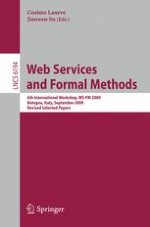2010 | Buch
Web Services and Formal Methods
6th International Workshop, WS-FM 2009, Bologna, Italy, September 4-5, 2009, Revised Selected Papers
herausgegeben von: Cosimo Laneve, Jianwen Su
Verlag: Springer Berlin Heidelberg
Buchreihe : Lecture Notes in Computer Science
